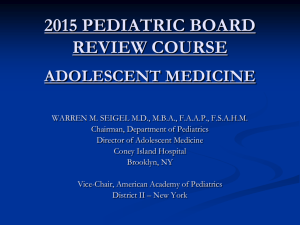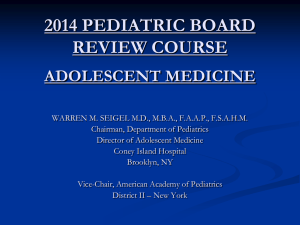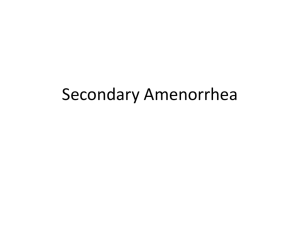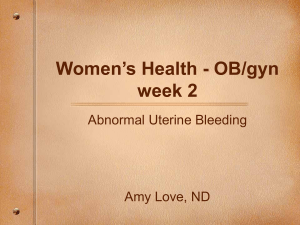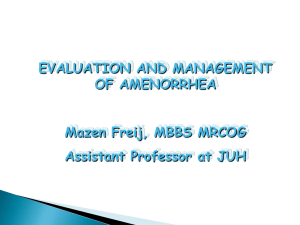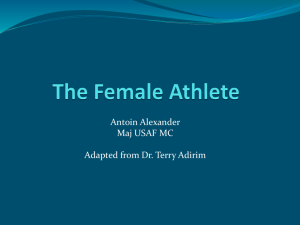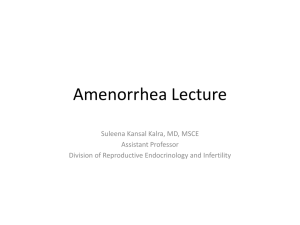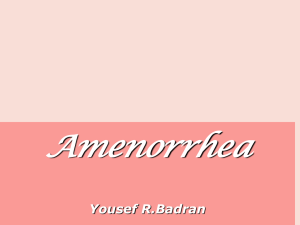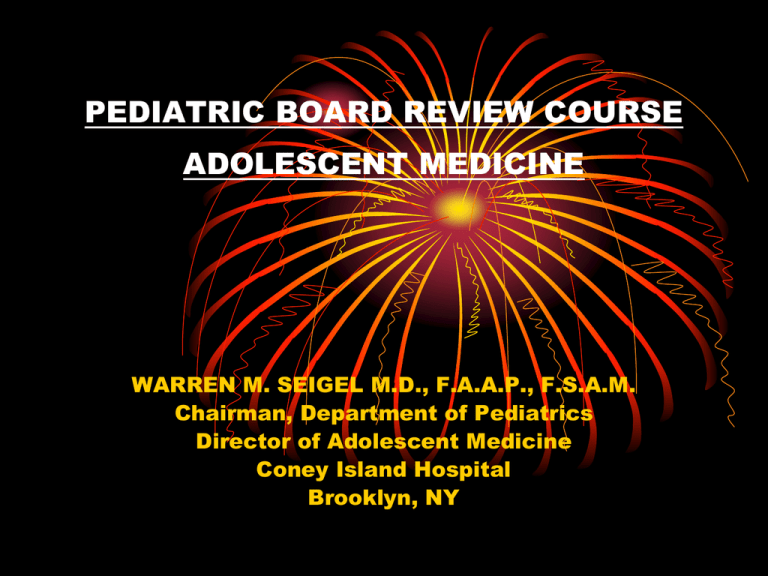
PEDIATRIC BOARD REVIEW COURSE
ADOLESCENT MEDICINE
WARREN M. SEIGEL M.D., F.A.A.P., F.S.A.M.
Chairman, Department of Pediatrics
Director of Adolescent Medicine
Coney Island Hospital
Brooklyn, NY
CASE #1
Katherine is a 14 year old female
who presents for a routine examination
for sports. She has no complaints. Her
past medical history and family history
are unremarkable.
On physical examination, you note
that she has Tanner 3 breasts and
Tanner 4 pubic hair.
QUESTIONS
• What is your differential diagnosis?
• Are Katherine’s physical
findings normal?
• How would you describe “Tanner 3”
breast development?
• How would you describe “Tanner 4”
pubic hair development?
• Has Katherine completed her
growth spurt?
• What actions would you take next?
PUBERTY
• Physical changes associated
with development
• Sequence of change is similar
for all adolescents
• Variations in tempo and timing
are common
• Physical changes reflect
underlying hormonal changes
SEQUENCE OF PUBERTY
• GIRLS
•
•
•
•
•
•
•
Breast Buds
Pubic Hair Appears
Growth Spurt
Axillary Hair
Pubic Hair Matures
Breasts Mature
Menarche (First
Period)
• Adult Height
• BOYS
• Testicular
enlargement
• Growth of
penis/scrotum
• Appearance of pubic
hair
• Axillary Hair
• First ejaculations
• Growth spurt
• Facial hair
• Adult Height
Features of Female
Development
• Onset:
• Growth
spurt:
• Height
Achieved:
• Menarche:
• Acne:
10 years (8-13)
Tanner 2 - 3
4 inches per year
12 years
common at
Tanner 3 - 4
Features of Male Puberty
•
•
•
•
Onset: 9-13 years (average = 12)
Peak Height Velocity: Tanner 3 - 4
First Ejaculations: Tanner 3
Average Height Gained:
5-7 inches/ year
• Strength Peak: Tanner 4 - 5
• Gynecomastia occurs in
approximately 60%
CASE #1
(continued)
Later in the course of your
history, you find out that
Katherine has tried tobacco,
drinks alcohol “on weekends
with my friends” and “smokes
weed once in a blue”.
QUESTIONS
• From a psychosocial perspective, in
what stage of adolescent
development is Katherine?
• What are some of the high risk
behaviors that she is most likely to
be at risk for in the near future?
• What are the leading causes of
morbidity and mortality in
Katherine’s age group?
• What actions would you take next?
FEATURES OF EARLY
ADOLESCENCE
(Am I Normal?)
•
•
•
•
•
•
•
•
•
Physical Changes and Concerns
Sense of Being “Center Stage”
Sense of Invulnerability
Wide Mood Swings
Rejection of Childhood Things
Beginnings of Emancipation
Non-Parent Adult Role Models
Same-Sex Friendships
Concrete Thinking
FEATURES OF MIDDLE
ADOLESCENCE
(Am I Liked?)
• Puberty (Almost) Complete
• Testing/Showing Off “New
Body”
• Independence-Dependence
Conflicts
• Strong Peer Attachments
• Concern With Sexual Appeal
• Experimentation/Risk-Taking
• Abstract Thinking Begins
FEATURES OF LATE
ADOLESCENCE
(Am I Loved?)
• Definition of Adult Role in Society
• Definition of Adult Role in Family
• Mainly Independent Decisions,
Actions
• Established, Realistic, Self-Identity
• Realization of Vulnerability,
Limitations
• Abstract Thinking Well Established
High Risk Behaviors
• Substance Abuse
• Alcohol
• 75% of all adolescents acknowledge
use
• Cigarettes
• use increasing among females
• Marijuana
• use increased among all age groups
• Cocaine
• level use
CASE # 2
Jonathon is a 16 year old
male who comes to your office
complaining of a clear urethral
discharge and burning on
urination for the past 1 week.
He admits to being sexually
active, the last time being 10
days ago.
QUESTIONS
• What is your differential
diagnosis?
• What additional history would
you like to obtain?
• What will you look for on your
physical examination?
• What actions would you take
next?
CHLAMYDIA
TRACHOMATIS
• MALES
• Asymptomatic
• Urethritis
• Epididymitis
• FEMALES
• Asymptomatic
• Cervictis
CHLAMYDIA: SIGNS AND
SYMPTOMS
• MALE: Burning, Urethral
Discharge, Pain in Epididymis
• FEMALE: Vaginal/Cervical
Discharge, Pelvic Pain, Painful
Intercourse, Burning
MAY BE NO SYMPTOMS IN
MALE OR FEMALE.
CHLAMYDIA
TRACHOMATIS
• DIAGNOSIS
• Culture: “gold standard”
• Leukocyte esterase; urine dip in
males
• Enzyme linked assay (EIA or
ELISA)
• Direct Fluorescent Antibody (DFA)
• DNA probes
• Nucleic Acid Amplification Tests
(NAATs)
CHLAMYDIA
TRACHOMATIS
• TREATMENT
• Azithromycin 1 gm single dose by
mouth
• Doxycycline 100 mg by mouth
twice daily for 7 days
• PARTNER TREATMENT!!!
• Follow-up “Test of Cure”
recommended
GONORRHEA: SIGNS AND
SYMPTOMS
• MALE: Yellow “Drip” from Penis,
Burning, Pain in Epididymis
• FEMALE: Vaginal/Cervical
discharge, Heavy Menses,
Painful Intercourse, Burning,
Frequency
MAY BE NO SYMPTOMS IN
MALE OR FEMALE
Neisseria Gonorrhea
• MALE
• Urethritis
• Epididymitis
• FEMALES
•
•
•
•
Asymptomatic
Cervicitis
Bartholin’s gland abscess
Pelvic Inflammatory Disease (PID)
NEISSERIA
GONORRHEA
• DIAGNOSIS
• Culture: “Gold Standard”
• Leukocyte esterase suggestive in
males
• DNA probes, PCR, EIA are all
available
• Nucleic Acid Amplification Tests
(NAATs)
NEISSERIA
GONORRHEA
• TREATMENT
• Ceftriaxone 125 mg IM in single
dose
• Cefixime 400 mg PO in single dose
• Ofloxacin 400 mg PO in single
dose
• Ciprofloxacin 500 mg PO in single
dose
ADDITIONAL TREAMENT FOR CHLAMYDIA
TRACHOMATIS IS TYPICAL
SYPHILIS: SITE OF
INFECTION
• MALE: Penis, Anus, Mouth, Lips
• FEMALE: Vulva, Vagina, Cervix,
Anus, Mouth, Lips
• INFANT: Acquired During Pregnancy,
Birth Defects, Death
Spread to entire body in male and
female including heart and brain!
SYPHILIS: SIGNS AND
SYMPTOMS
• PRIMARY SYPHILIS
• Chancre on sex organs
• SECONDARY SYPHILIS
• Fever, rashes, generalized illness
• TERTIARY SYPHILIS
• Infection of brain, blood vessels
SYPHILIS
• PRESENTATION
• Primary chancre
• Indurated ulcer with smooth
borders
• Painless
• Incubation of approximately 3
weeks
• Healing in approximately 6 weeks
SECONDARY SYPHILIS
• CONSTITUTIONAL SYMPTOMS
• Fever, malaise, adenopathy,
musculoskeletal
• SKIN AND MUCOUS MEMBRANE
FINDINGS
• Rash – begins on trunk
• Rash – involves palms and soles
• Condyloma lata – moist plaques
• Alopecia
SKIN LESIONS ARE HIGHLY
INFECTIOUS!
Diagnosis – Syphilis
• Serologic – nontreponemal
• RPR, VDRL, ART
• Serologic – treponemal
• FTA-ABS, MHATP,TPHA
Treatment – Syphilis
• Less than 1 year duration –
• Benzathine Penicillin-G 2.4 million
units IM
• Greater than 1 year duration –
• Benzathine Penicillin-G 7.2 million
units, 3 divided doses
Trichomonas
• Males
• Generally asymptomatic
• Females
• Malodorous vaginal discharge
• Cervicitis
• Vulvitis with labial edema
Trichomonas
• Diagnosis
• Observation of flagellate on saline
wet mount
• Treatment
• Metronidazole 2 gm po x 1 dose
Bacterial Vaginosis
•
•
•
•
•
Non-gonococcal
Non-chlamydial
Non-trichomonal
Non-candidal
Due to Gardnerella vaginalis
Bacterial Vaginosis
• Symptoms
• Vaginal discharge- grey-white, thin
, watery
• Pruritis and itching may
accompany
• Worsens with intercourse
• Malodorous
• Diagnosis
• Saline wet prep with “clue” cells
Bacterial Vaginosis
• Treatment
• Metronidazole 500 mg PO bid X 7
days
Genital Herpes: Site of
Infection
• Males: Blisters on Penis,
Scrotum, Buttocks
• Females: Blisters on Vulva,
Vagina, Cervix, Buttocks
• Infants: Systemic
Genital Herpes:
Signs and Symptoms
• Primary Infection: Very Painful
Painful Urination
1-3 weeks
• Repeat Infections: Less Painful
1 Week or less
Herpes Simplex - HSV
• Skin lesions appear at site
within 2-14 days
• Grouped papules on
erythematous base
• Ulceration Erosion
• Very painful
• Constitutional symptoms
Genital Herpes:
Treatment
• Treat Virus
• Treat Symptoms
• No sex until 1 week after
blisters heal
• Treat partner only if infected
Treatment:
Genital Herpes
• Primary
• Acyclovir 400 mg oral tid X 7-10
days
• Recurrent
• Acyclovir 400 mg oral tid X 5 days
• Prophylaxis
• Acyclovir 400 mg oral bid
Genital Herpes
• 1.First Episode
• Acyclovir (ACV) 200 mg (400mg for proctitis)
• PO 5x per day for 7-10 days
• 2. Recurrent Episodes – usually no
treatment, if necessary:
• A) ACV 200 mg PO 5x per day for 5 days
• B) ACV 400 mg PO TID for 5 days
• C) ACV 800 mg PO BID for 5 days
• 3. Suppressive Therapy
• A) ACV 400 mg PO BID
• B) ACV 200 mg po 2-5 times/day
• 4.Severe disease
• ACV 5 -10 mg/kg IV every 8 hours X 5-7 days
• 5. No role for topical ACV
Human Papilloma Virus
• Most common STI
• Increasing prevalence among
teens
• Associated with majority of Pap
smear abnormalities
Human Papilloma Virus
• Treatment
•
•
•
•
Podophyllin
Cryotherapy with liquid nitrogen
Podofilox ( home treatment )
Interferon available (not currently
recommended)
CASE # 3
Over the past 6 months,
Marianne, a 15 year old girl in
your practice, has missed 8
days of school because of
severe, episodic lower
abdominal pain that coincides
with menses. Menarche was at
age 13 and menses are regular.
She states that she is not
sexually active. Findings on
physical exam are normal.
QUESTIONS
• What is your differential
diagnosis?
• What will you look for on
physical examination?
• What actions would you take
next?
Normal Menstruation
• Normal menstruation is an indication
that the hypothalamic--pituitary-ovarian--uterine axis is intact and
responsive.
Physiology of Menses
• FSH - stimulates the maturation of
ovarian follicles
- directs the conversion of
androgens in the granulosa
cells of the ovary to estrogens
• LH - stimulates theca cells of the
ovary to produce androgens
- midcycle LH surge stimulates
ovulation
Physiology of Menses
• Estrogens- stimulate the proliferation of
endometrial epithelial and stromal cells.
Stimulate glandular formation.
• Progesterone- produced by corpus
luteum, causes the endometrium to
function in a secretory manner, leading
to increased blood vessel growth and
tortuosity.
Normal Menstrual Cycles
Follicular Phase
Ovulatory Phase
Luteal Phase
Follicular Phase
• Endometrial proliferation under estrogen
influence
• Endometrial stroma becomes compact
• Estrogen triggers midcycle LH surge
• Cervical mucus is watery
Ovulatory Phase
• Following ovulation, corpus luteum
produces both Estrogen and
Progesterone.
• Progesterone exerts suppressive
effect on Estrogen resulting in the
conversion of the endometrium to a
secretory state.
Ovulatory Phase
• Vaginal secretions and Cervical
mucus are copious and clear.
• Secretions placed on glass slide
will demonstrate “ferning” pattern
when allowed to dry. (know this !)
Case # 3
(continued)
Upon further questioning,
Marianne admits that her last
menstrual period was
approximately 8 weeks ago.
She is sexually active with a
single male partner and does
not use condoms consistently.
QUESTIONS
• What is your differential
diagnosis?
• What will you look for on
physical examination?
• What actions would you take
next?
Menstrual Abnormalities
•
•
•
•
•
Primary Amenorrhea
Secondary Amenorrhea
Dysmenorrhea
Dysfunctional Uterine Bleeding
Polycystic Ovary Disease
Amenorrhea
• Definition: Amenorrhea is the
absence of menses.
Amenorrhea
• Primary Amenorrhea:
• The lack of menses by age 14 with the
absence of secondary sexual
characteristics.
• The lack of menses by age 16 regardless
of the status of secondary sexual
characteristics.
Amenorrhea
• Secondary Amenorrhea:
• Absence of menses for a
period of at least 3 cycle
lengths or for a period of 6
months.
Primary Amenorrhea
• Differential Diagnosis
•
•
•
•
Hypothalamus
Pituitary
Ovary
Uterus & Outflow Tract
Primary Amenorrhea
• Hypothalamic Causes
•
•
•
•
•
•
•
Physiologic delay – often familial
Systemic disease – often chronic
Stress
Athletics
Eating Disorders
Obesity
Drugs
• Cytoxin, Phenothiazines, Isotretinoin,
Amphetamines
• Steroids, Opiates
Primary Amenorrhea
• Pituitary Causes
• Idiopathic Hypopituitarism
• Tumor
• Hemochromatosis
Primary Amenorrhea
• Thyroid and Adrenal Gland
Causes
•
•
•
•
Hypothyroidism
Hyperthyroidism
Congenital Adrenal Hyperplasia
Tumor
Primary Amenorrhea
• Gonadal Causes
•
•
•
•
•
Turner Syndrome and Mosaicism
Pure Gonadal Dysgenesis
Testicular Feminization Syndrome
Hermaphroditism
Ovarian Failure
Primary Amenorrhea
• Uterus and Outflow Tract
Causes
•
•
•
•
Synechiae
Pregnancy
Agenesis
Imperforate Hymen
Evaluation of Primary
Amenorrhea
• History
• Physical Examination
• Pelvic Examination
• Ultrasound if needed to define anatomy
• FSH, LH, Prolactin, Testosterone
• Bone Age
• Karyotype
Secondary Amenorrhea
• Think
• Pregnancy
• Pregnancy
• Pregnancy
Secondary Amenorrhea
• Hypothalamic Causes
• Stress
• Exercise
• Obesity
• Eating disorders
• Drugs
• Cytoxin, Phenothiazines, Isotretinoin,
Amphetamines
• Steroids, Opiates
• Systemic
• Enteritis, colitis
• Diabetes
• CF, renal disease
Secondary Amenorrhea
• Pituitary Causes
• Hyperprolactinemia
• Pituitary Adenoma
• Post-Oral Contraception
Secondary Amenorrhea
• Thyroid Causes
• Hyperthyroidism
• Hypothyroidism
Secondary Amenorrhea
• Adrenal Causes
• Congenital Adrenal Hyperplasia
• Adrenal Tumor
Secondary Amenorrhea
• Gonadal Causes
• Polycystic Ovary Syndrome
• Gonadal Dysgenesis
• Ovarian Failure
Secondary Amenorrhea
• Uterus and Outflow Tract
Causes
• Asherman Syndrome
• scarring from D&C
• Tumor
Evaluation of Secondary
Amenorrhea
• Complete History & Physical Exam
• Pelvic Examination
• Pregnancy Test
Evaluation of Secondary
Amenorrhea
• Pregnancy Test NEGATIVE:
• Provera, 10 mg BID X 5 days
• Withdrawal bleed indicates:
• Ovaries produce adequate estrogen to
stimulate endometrial proliferation in the
uterus. Also indicates that the outflow tract
is intact and functioning normally.
Evaluation of Secondary
Amenorrhea
• Lab Evaluation:
• CBC with diff, ESR
• UA
• FSH, LH, prolactin
• Radiologic Evaluation:
• pelvic ultrasound
Dysmenorrhea
• Definition – pain associated with
menses
• Etiology:
Prostaglandin PGE2 and PGF2
implicated
Endometriosis
• Onset within 6-12 months following
Menarche
Dysmenorrhea
• Lower abdominal to back/thigh
pain reported
• Polyps, benign tumors
• Infection
Dysmenorrhea
• Differential Diagnosis
•
•
•
•
Endometriosis
Pelvic Inflammatory Disease
Benign Tumor
Anatomic abnormality
Workup for Dysmenorrhea
• Complete physical examination
including pelvic exam
• CBC with differential, ESR
• GC/chlamydia screen
• Wet mount of discharge if
present
Management of Dysmenorrhea
• Infection – treat
• Endometriosis – refer to GYN
• No abnormality on evaluation
• Non-steroidal anti-inflammatory agent
• Reassurance
• If no improvement with NSAIDS,
estrogen/progesterone combination
contraceptive
CASE #4
Adrienne is a 14 year old female
who complains of vaginal bleeding
for the past month. She states that
she has been using approximately 6
– 8 pads per day and that her
bleeding has been heavier than
usual. Menarche was at 13 years.
She denies sexual activity.
QUESTIONS
• What is your differential
diagnosis?
• What additional history would
you want to obtain?
• What will you look for on
physical examination?
• What actions would you take
next?
Dysfunctional Uterine
Bleeding
• Polymenorrhea – bleeding which
occurs at regular intervals of
less than 21 days
• Menorrhagia – prolonged or
excessive bleeding at regular
intervals of 21-35 days
• Metrorrhagia – irregular interval
bleeding
Dysfunctional Uterine
Bleeding
• Etiology – anovulatory bleeding
secondary to immature
hypothalamic-pituitary-ovarian
axis
Dysfunctional Uterine
Bleeding
• Differential Diagnosis
• Anovulatory Bleeding
• Pregnancy complications
• Ectopic, spontaneous abortion
•
•
•
•
Endometritis
Malignancy
Iatrogenic
Ovarian
Dysfunctional Uterine
Bleeding
Evaluation
• Complete History and Physical
Exam
• Menstrual and Sexual History
• Pregnancy Test
• CBC with differential
• Platelet Count
• PT/PTT
Management of Dysfunctional
Uterine Bleeding
• If Hemoglobin is stable
• Observation and reassurance
• Begin Iron Therapy
• Combination estrogen/progestin
contraceptive pills
Management of Dysfunctional
Uterine Bleeding
• If bleeding is severe,
Hemoglobin unstable
• Estrogen every 4-6 hours until
bleeding is stopped
• The begin Estrogen containing
pills as maintenance
Polycystic Ovary Disease
• Anovulatory cycles with
irregular bleeding
• Suspect in the mid adolescent
with menstrual irregularity
Polycystic Ovary Disease
• Etiology: Defect in gonadotropin
secretion leading to elevated
LH. FSH is normal/borderline
low.
• Acyclic estrogen/progesterone
secretion
• Elevated Androgen secretion
• Anovulation
Polycystic Ovary Disease
• Presentation
•
•
•
•
Amenorrhea
Hirsuitism
Obesity
Infertility
Polycystic Ovary Disease
• Differential Diagnosis
• Familial Hirsuitism
• Cushing’s Syndrome
• Androgen excess
• Late onset CAH (21-hydroxylase
deficiency)
• Androgen producing tumor
• Anabolic steroid use
Polycystic Ovary Disease
• Evaluation
• History including
PMH
• Medication History
• Menstrual History
• Sexual History
including
pregnancy,
infection, abortion
• Physical Exam
• Obesity
• Hirsuitism
• Clitoromegaly
Polycystic Ovary Disease
• Pelvic Examination
• Size of ovaries
• Laboratory Evaluation
• LH/FSH, E2, DHEAS, Testosterone,
17-OH Progesterone
• Ultrasound
• Size of Ovaries
Polycystic Ovary Disease
• Treatment
• Normalization of Menses
• Estrogen dominant Oral
Contraceptive Pill
• Hirsuitism
• Weight Loss
• Cosmetics
• Fertility
• Clomid
• Metformin
CASE #5
Mark is a 15 year old boy who
comes to your office for a routine
physical examination. His mother
asks to meet with you alone and
says that a few weeks ago she found
a plastic baggy with marijuana under
his bed. She requests that you
perform a drug test without telling
her son.
QUESTIONS
• Will you perform the drug test
without telling Mark?
• If not, what will you tell Mark as
an alternative?
• What will you tell Mark about
drug testing?
Substance Abuse
• Definition: The persistent use of
illicit substances despite
experiencing negative
consequences from their use.
Substance abuse is a multidimensional disorder with a
complex biopsychosocial
etiology.
Multiple Drug Use
• Adolescents rarely report a
“drug of choice” but rather
use multiple substances.
Age at First Use
• The age of first use for US teens
is 11-12 years of age.
Case #5
(continued)
Mark’s grades have been falling
and he quit the football team
recently. He has a new group of
friends that he never brings home.
Mark tells you that he occasionally
smokes marijuana but he denies
using any other drugs. He admits to
being sexually active and drinking
beer with his friends on weekends.
QUESTIONS
• What is your differential
diagnosis?
• What will you look for on
physical examination?
• What actions would you take
next?
Risk Factors for Illicit
Drug Use
• Family Tolerance
• Peer Influences- The most positive
predictor of drug and alcohol use
among teens, is a positive history of
use among peers.
• Other Factors
• Early Academic Failure
• Isolation
• Criminal Activity
Recognizing Substance
Abuse Problems
• Behavioral Change
• Unexpected Decline in School
Performance
• School Problems & Behavioral
Concerns
• Isolation from peers
• Outbursts of anger or abusive
behavior without remorse
Obtaining the History
• With the teen separated from
parent/s
• With assurance that the
substance use history is part of
a routine interview
(it should be !)
• With appropriate lead in
questions...
Lead Ins…..
• Many teens your age go to
parties where alcohol is
available…do you ?
• Have you ever consumed a
drink containing alcohol ?
• Have you ever been drunk ?
The CAGE
• C = the need to CUT DOWN
• A = has someone been
ANNOYED because of alcohol or
drug use
• G = have you felt GUILTY
because of something which
happened
• E = have you ever used in the
morning as an EYE OPENER
The “C.R.A.F.F.T.”
• C -- Have you ever ridden in a CAR driven
by someone (including yourself) who was
"high" or had been using alcohol or drugs?
• R -- Do you ever use alcohol or drugs to
RELAX, feel better about yourself, or fit in?
• A -- Do you ever use alcohol or drugs while
you are by yourself, ALONE?
• F -- Do you ever FORGET things you did
while using alcohol or drugs?
• F -- Do your family or FRIENDS ever tell you
that you should cut down on your drinking
or drug use?
• T -- Have you gotten into TROUBLE while
you were using alcohol or drugs
Drug Screening
• Ethical Issues- screening
without the knowledge and
consent will likely have a
negative effect on the doctorpatient relationship.
• The AAP does not endorse such
“non-informed” screening.
Drug Screening...
• Obtain the appropriate sample
• Either urine or serum are adequate
for general screening.
• The use of hair for screening is
more sophisticated than generally
necessary for routine screening.
Drug Screening...
• How long will drug screening
remain positive ?
•
•
•
•
•
•
Amphetamines- < 48 hours
Barbiturates- 3-4 days
Cocaine- 2-4 days maximum
Ethanol- 2-14 hours
Opiates- 2 days
Cannabinoids- 10 - 20 days
maximum
FIVE STAGES OF
SUBSTANCE ABUSE
•
•
•
•
STAGE
STAGE
STAGE
STAGE
1
2
3
4
• STAGE 5
CURIOSITY
EXPERIMENTATION
REGULAR USE
PSYCHOLOGIC OR
CHEMICAL
DEPENDENCY
USING DRUGS TO
FEEL “NORMAL”
CASE #6
Adrienne is a 13 year old female
who is brought to you by her mother
for a physical examination. She has
no complaints and her past medical
history is unremarkable. The mother
requests that you examine her
daughter “to see if she’s a virgin”
and if not, the mother requests that
you start her on some form of
contraception.
QUESTIONS
• What is your differential
diagnosis?
• What additional history would
you want to obtain?
• What will you look for on
physical examination?
• What actions would you take
next?
Adolescent Sexual
Behavior
• 80% of Males and 70% of
Females have intercourse
before age 20
• Average age of first intercourse
is 16
• Often a series of single partners
Considerations in
Contraceptive choice for
Adolescents
•
•
•
•
•
•
•
•
Frequency of Intercourse
Number of Partners
Acceptability
Motivation and Self-Discipline
Access to Medical Care
Effectiveness
Safety vs. Risk
Cost
Prevention: Abstinence
•
•
•
•
Effective
No Cost
Applicable for all
Requires Willpower for Both
Partners
Prevention: Withdrawal
• Penile withdrawal before
Ejaculation
• No cost
• Effectiveness 77-84%
• Does Not Prevent STIs
• Always Available
• Choice of last resort for
adolescents
Prevention: Fertility
Awareness
• Recognition of Fertile and Safe
Times in Cycle
• Effectiveness 76-98%
• No Major Health Concerns
• No Cost
• Difficult if Irregular Cycles
• Requires Discipline in Both Partners
• Poor Choice for Adolescents
Prevention: Condoms
• Condoms Prevent Sperm from
entering Vagina
• Must be in place prior to contact
with vagina and during withdrawal
• Effectiveness 90-98%
• Over-the-counter Availability
• Best protection against STIs
• Requires Motivated Couple
• Appropriate for Casual Sex Partner
• Appropriate for Motivated Male
Prevention: Diaphragm
• Barrier to Cervix
• Must be fitted professionally
• Must be in place prior to sexual
contact and 6 hours after
• Effectiveness 81-98%
• Requires physical exam
• Can be inconvenient
• Appropriate for very motivated teen
in Stable Relationship
Prevention: Intrauterine
Device (IUD)
•
•
•
•
•
•
•
Prevents Implantation (Theory)
Device placed inside Uterus
Effectiveness 95-98%
Limited availability
Requires Medical Surveillance
Increases risk of PID, infertility
Rarely appropriate for
adolescents
Prevention: Sponge
• Disposable Barrier to Cervix
• Moistened Sponge used similar to
Diaphragm
• Effectiveness 80-91%
• Over-the-counter availability
• Some protection form STDS
• Expensive if Frequent Intercourse
• Appropriate for Motivated teen
• Good Back-up Method
Prevention: Foam and
Spermicides
• Chemical destruction of sperm in
vagina
• Must be in place prior to intercourse
• Effectiveness 82-97%
• Over-the-Counter availability
• Some protection From STIs
• Requires Motivated couple
• Appropriate for Motivated
adolescents
Prevention: Sterilization
• Permanent Surgical Sterilization
Male or Female
• Effectiveness more than 99%
• Medically performed
• Not appropriate for adolescents
Prevention:
Injectable Hormones
•
•
•
•
Suppresses Hormone Cycle
Injection every 1-3 month
98-99% effective
Long Lasting, Unrelated to
Intercourse
• Requires More Frequent Medical
Visits
Prevention:
Morning After Pill
• Taken Post Intercourse to prevent
implantation
• Effectiveness 99%
• Emergency Method for Rape,
Contraceptive Failure
• Not regular Birth Control Method
• Requires Medical Evaluation
• Appropriate for Emergency Use in
Adolescents
Module #8-15
Prevention: Emergency
Contraception (EC)
• Taken Post Intercourse to prevent
implantation
• Effectiveness 99%
• Emergency Method for Rape,
Contraceptive Failure
• Not regular Birth Control Method
• Requires Medical Evaluation
• Appropriate for Emergency Use in
Adolescents
•
•
•
•
•
•
•
•
Prevention: Hormonal
Contraceptives
Hormonal Prevention of Ovulation
Requires regular Professional Care
Effectiveness 98-99%
Multiple Health Benefits
Risk of Medical Complications lowest
in Adolescents
Must be taken Every Day
Minor Side Effect Possible
Often Method of Choice for
Adolescents
Module #8-14
Contraceptive Patch
Estrogen and Progestin Delivery
• Patch contains 6.00 mg norelgestromin
and 0.75 mg ethinyl estradiol
• Delivers continuous systemic doses of
hormones
• 150 µg norelgestromin (NGMN)
+
• 20 µg ethinyl estradiol (EE) per day
Abrams L, et al. FASEB J. 2000;14;A1479.
Etongestrel/Ethinyl Estradiol
Vaginal Ring
Progestin: Etonogestrel: 120 µg/day
Estrogen: Ethinyl Estradiol: 15 µg/day
• Worn for three out of four weeks
• Self insertion & removal
• Pregnancy rate 0.65 per 100 womanyears
Roumen FJ, et al. JUM Reprod. 2001;16(3):469-475.
Absolute Contraindications
for Hormonal Contraception
• Past or current history of
•
•
•
•
Thromboembolic disorder
Cerebrovascular disease
Breast cancer
Estrogen dependent neoplasia
• Prolonged immobilization
• Acute liver function impairment
• Pregnancy
Relative
Contraindications
•
•
•
•
•
•
•
Vascular or migraine headaches
Collagen vascular diseases
Severe hypertension
Chronic heart disease
Sickle cell disease
Severe renal disease
Diabetes mellitus
GOOD LUCK!

